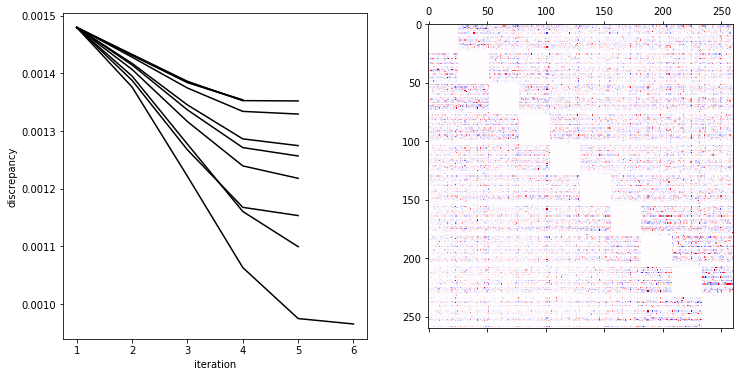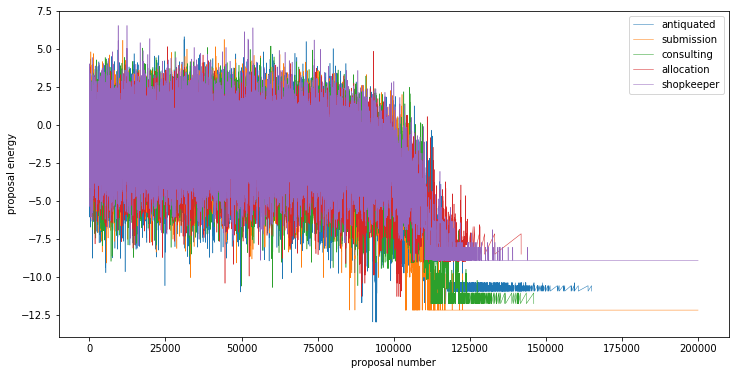Anagram solver¶
In this example, we train a model to predict a missing letter in a 10-letter word. We then use the natural definition of energy in the model to solve anagrams by descending the energy function. We use a data set of words that were scraped from news sites, blogs, and Twitter.
In [1]:
%matplotlib inline
import matplotlib.pyplot as plt
import numpy as np
import pandas as pd
import fem, os, time, pickle
data_dir = '../../../data/words'
print 'number of threads: %i' % (fem.fortran_module.fortran_module.num_threads(),)
cache = True
number of threads: 8
We load the word data into to the words then select a sample of the
words in the variabel x to train the model.
In [2]:
# load word data
n = 10
words = np.loadtxt(os.path.join(data_dir, '%02i.txt' % (n,)), dtype='U%i' % (n,))
# select a sample of words and separate into array of letters
l = int(1e6)
words_sample = np.random.choice(words, size=l, replace=False)
x = np.array([np.array(list(word)) for word in words_sample]).T
print 'word length: %i, number of words: %i' % x.shape
word length: 10, number of words: 1000000
Next, we create a model model and fit it to the word sample using
model.fit(x, ...).
We plot the model parameter \(W\) heat map and the running discrepancies calculuated during the fit below.
In [3]:
model_file = os.path.join(data_dir, '%02i.pkl' % (n,))
if cache and os.path.exists(model_file):
with open(model_file, 'r') as f:
model = pickle.load(f)
print 'loaded cached model'
else:
model = fem.discrete.model()
start = time.time()
model.fit(x, overfit=False, svd='exact')
end = time.time()
print 'fit time: %.02f minutes' % ((end-start)/60.,)
with open(model_file, 'w') as f:
pickle.dump(model, f)
fig, ax = plt.subplots(1, 2, figsize=(12,6))
for d in model.disc:
ax[0].plot(1+np.arange(len(d)), d, 'k-')
ax[0].set_xlabel('iteration')
ax[0].set_ylabel('discrepancy')
scale = np.abs(model.w[1]).max()
ax[1].matshow(model.w[1], aspect='equal', cmap='seismic', vmin=-scale, vmax=scale)
plt.show()
loaded cached model

The natural definition of the energy of the word \(w\) given the
model with parameters \(W\) is
\(E(\sigma)=-\frac12\sigma^TW\sigma\) where \(\sigma\) is the
one-hot encoding of \(w\). We may use this energy to design a Markov
chain Monte Carlo approach to solve anagrams, that is to rearrage the
letters in a given permuted word with permuted letters to recover the
original word. The function solve_anagram below uses the simulated
annealing approach to attempt to solve anagrams under the assumption
that the original word minimizes the energy function constrained to the
set of permuations of the input anagram.
Given an anagram \(w\), we propose a modified anagram \(\tilde{w}\) by swapping a random pair of adjacent letters in \(w\).
We accept the proposal with probability
\(\exp\left({E(w)-E(\tilde{w})\over T}\right)\) where \(T\) is a
temperature that decays exponentially from \(T_{max}>1\) at step 0
to \(T_{min}<1\) at step max_steps. We record the anagram with
the lowest energy encountered and return that as the final guess.
We plot the running energies for a number of example anagrams below. Additionally, we tabulate the solution, initial anagram, and the best guess as well as their energies below.
In [4]:
def solve_anagram(anagram, max_steps=int(2e5)):
def propose(anagram, pairs):
"""Propose a new anagram by swapping adjacent letters"""
pair = pairs[np.random.randint(n-1)]
proposal = np.array(list(anagram))
proposal[pair] = proposal[pair][::-1]
proposal = ''.join(proposal)
return proposal
def accept(anagram_energy, proposal_energy, t=1.0):
"""Accept proposed anagram with simulated annealing probability"""
p = np.exp((anagram_energy - proposal_energy) / t)
return np.random.uniform() < p
def temperature(step, max_steps, t_min=1e-2, t_max=1e2):
"""Return temperature given progress to max_steps"""
return t_max * np.exp(step / float(max_steps) * np.log(t_min / t_max))
# pairs of neighboring letter indices
pairs = np.stack([range(n)[:-1], range(n)[1:]]).T
# initial energy
anagram_energy = model.energy(anagram)
energy_history = [[0, anagram_energy]]
# best guess
answer = [anagram, anagram_energy]
for step in range(max_steps):
# propose new anagram and compute energy
proposal = propose(anagram, pairs)
proposal_energy = model.energy(proposal)
if accept(anagram_energy, proposal_energy, temperature(step, max_steps)):
# update current guess
anagram, anagram_energy = proposal, proposal_energy
energy_history.append([step, anagram_energy])
# record buest guess
if anagram_energy < answer[1]:
answer = [anagram, anagram_energy]
energy_history = np.array(energy_history).T
return answer, energy_history
tab, e = [], []
# for a random selection of words
for word in np.random.choice(words, size=5, replace=False):
# make an anagram by permuting the letters in the word
anagram = ''.join(np.random.permutation(list(word)))
# solve the anagram with a simulated annealing approach
answer, energy_history = solve_anagram(anagram)
tab.append([word, model.energy(word), anagram, model.energy(anagram), answer[0], answer[1]])
e.append(energy_history)
fig = plt.figure(figsize=(12,6))
ax = plt.gca()
for i, ei in enumerate(e):
ax.plot(*ei, lw=0.5, label=tab[i][0])
ax.set_xlabel('proposal number')
ax.set_ylabel('proposal energy')
plt.legend()
plt.show()
tab = pd.DataFrame(data=tab, columns=['word', 'energy', 'anagram', 'energy', 'answer', 'energy'])
tab

Out[4]:
| word | energy | anagram | energy | answer | energy | |
|---|---|---|---|---|---|---|
| 0 | antiquated | -12.952297 | tqeiutdaan | 0.094032 | antiquated | -12.952297 |
| 1 | submission | -12.171518 | iosumisbsn | 0.337162 | submission | -12.171518 |
| 2 | consulting | -11.747188 | cnnitgulso | -0.964849 | consulting | -11.747188 |
| 3 | allocation | -9.194562 | ooaanltlci | 1.586637 | coallation | -11.280581 |
| 4 | shopkeeper | -5.826653 | oerhspeepk | 1.823975 | pekeershop | -8.900936 |
There are adversarial examples to show the anagram solver. For example, we demonstrate that the search repeatedly guesses “impression” given an anagram of “permission” because the model is in a lower energy state at “impression.”
In [5]:
# adversarial examples:
# permission <-> impression
# nonduality <-> undylation
# treatments <-> restatement
word = 'permission'
print 'word: %s, energy: %f' % (word, model.energy(word))
tab = []
for attempt in range(5):
anagram = ''.join(np.random.permutation(list(word)))
answer = solve_anagram(anagram)[0]
tab.append([anagram, model.energy(anagram), answer[0], answer[1]])
tab = pd.DataFrame(data=tab, columns=['anagram', 'energy', 'answer', 'energy'])
tab
word: permission, energy: -10.574511
Out[5]:
| anagram | energy | answer | energy | |
|---|---|---|---|---|
| 0 | emrpoinssi | -1.859870 | impression | -13.795883 |
| 1 | sirspmeoni | -2.762323 | impression | -13.795883 |
| 2 | meriposins | -1.256509 | impression | -13.795883 |
| 3 | oneiirsmsp | -0.925506 | impression | -13.795883 |
| 4 | nismespiro | -0.899383 | impression | -13.795883 |